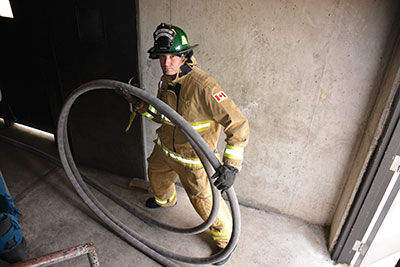
Features
Training
Tim-Bits: July 2013
In the April edition of Tim-Bits, I discussed a simple solution to flaking a long fire attack hoseline in a short space by creating piled loops of uncharged hose, starting from the back and ending with the nozzle on top.
June 21, 2013
By Tim Llewellyn
In the April edition of Tim-Bits, I discussed a simple solution to flaking a long fire attack hoseline in a short space by creating piled loops of uncharged hose, starting from the back and ending with the nozzle on top. Upon charging the hoseline, the loops fill virtually kink-free and an easier hose stretch is afforded. Many will argue, however, that this method may create unnecessary hardship for the firefighters. This argument is valid because advancing a charged hoseline from the point of entry to the fire is more difficult than advancing a dry hoseline. So, let’s look at techniques that make the job of advancing a charged hoseline easier and more productive for the nozzle and back-up firefighters, especially in short-staffing situations.
 |
|
| The backup firefighter can stand the hose loops upright, and the loops can be rolled in the direction of the fire area. Each loop can contain between five and eight metres of hose. Photo by Laura King
|
The two main responsibilities of the back-up firefighter are to ensure that the nozzle firefighter has enough hose to get to the fire and to keep the entire hose length free of kinks. Often, the back-up firefighter will take a position on a corner inside the building, and will pull the hose around the corner and push it toward the nozzle firefighter. Although effective, it is not the most efficient use of energy. This method can be very taxing on the back-up firefighter, potentially rendering him useless if the hose stretch is long and difficult.
If the team has used the loop method to flake the hose load, an alternative method involves the back-up firefighter rolling the loops of hose that were formed outside of the house. When the hoseline is charged, the nozzle firefighter advances toward the house approximately seven to 10 metres from the pile of loops created earlier. The back-up firefighter then picks up the top two or three loops of attack hose from the ground and follows the nozzle firefighter into the structure. Once inside the house, the back-up firefighter can stand the hose loops in an upright position, using the wall or other furniture for support. These loops can then be rolled in the direction of the fire area or an advanced hose staging area, ready for deployment. Each loop could contain between five and eight metres of hose. In an average sized residential structure, two loops would offer almost enough hose to reach an entire floor, if deployed correctly. Another advantage of this type of hose management is that the excess hose is kept up off of the floor, creating less of a tripping hazard for other firefighters who might be working in the area.
Often, the nozzle firefighter will enter the structure and have to immediately advance the hoseline up a stairwell for a second-floor fire. Most often, the firefighter will ascend the stairs with the nozzle in hand, pulling the hose up the stairs behind him while the back-up firefighter feeds hose from below. This task can easily be accomplished by the nozzle firefighter alone, thereby allowing the back-up firefighter to prepare to advance all of the loops at the same time. The nozzle firefighter advances away from the pile of loops toward the bottom of the stairs. Once there, he places the nozzle on the floor at the corner of the wall and the bottom stair. The nozzle firefighter then places his foot on the nozzle to prevent it from sliding or moving during the next operation. The hose behind the nozzle is then formed into a U shape and is pushed up the stairs until the bottom of the U is at the top of the stairs on the landing. Next, the nozzle firefighter retrieves the nozzle from the floor and advances it up the stairs in a normal manner. This manoeuvre will not only allow the nozzle firefighter to advance up the stairwell with greater ease, but also afford him a workable length of hose to use once at the top of the stairs, while the back-up firefighter prepares to advance the remaining loops of hose from below.
Advancing a charged hoseline can be difficult, but the job can be made a lot easier with the help of continued and realistic training and these simple, tried-and-true techniques.
Tim Llewellyn is a career firefighter for the Allegheny County Airport Authority in Pittsburgh, Penn. A volunteer firefighter since 1989, he currently serves for the Adams Area Fire District in Pennsylvania. He has recently been appointed as a suppression-level instructor for the Pennsylvania State Fire Academy. He has taught structural firefighting tactics extensively in Canada and the U.S. E-mail him at llewllyn.fire@gmail.com
Print this page